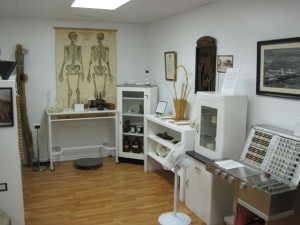Stop 5: Weyburn Mental Hospital
Yes, Saskatchewan’s famous hospital was torn down last spring despite efforts to save the building and internet petitions (click here for a summary of its last years). And yes, the site currently consists of a large pile of bricks surrounded by chain-link fence [pictured right]. However, a good collection of artifacts from the Weyburn Mental Hospital can be found at the local museum: the Soo Line Historical Museum.
The Weyburn Mental Hospital opened in 1921 and over the years employed a variety of treatments: hydrotherapy, lobotomy, electroshock treatments,various forms of occupational therapy, etc. But what many Canadians tend to associate with the institution are the experimental hallucinogenic drug treatments that were carried out in the 1950s. Led by Dr. Humphry Osmond, who has been credited for coining the term “psychedelic”, the experiments involved drugs such as LSD, mescaline, and peyote and involved staff as well as patients.
 The Soo Line Museum has dedicated an entire room to the history of the city’s famous hospital [a portion of which is pictured left]. The display begins with a wall of patient-created art and moves into a large collection of photographs of the various buildings, activities, and persons affiliated with the institution. The remainder of the room displays items that trace the various treatment programs that were used over the history of Weyburn as well as the day-to-day life activities of an institution.
The Soo Line Museum has dedicated an entire room to the history of the city’s famous hospital [a portion of which is pictured left]. The display begins with a wall of patient-created art and moves into a large collection of photographs of the various buildings, activities, and persons affiliated with the institution. The remainder of the room displays items that trace the various treatment programs that were used over the history of Weyburn as well as the day-to-day life activities of an institution.
[…] held by the Canada Science & Technology Museum in Ottawa, Ontario. The machine is from the Weyburn Mental Hospital in Weyburn, Saskatchewan. It was was donated to the shortly after the hospital was torn down in […]